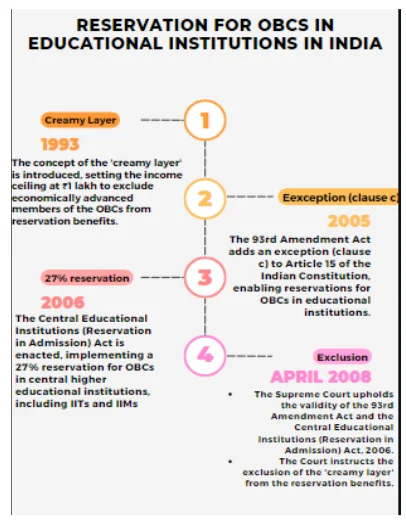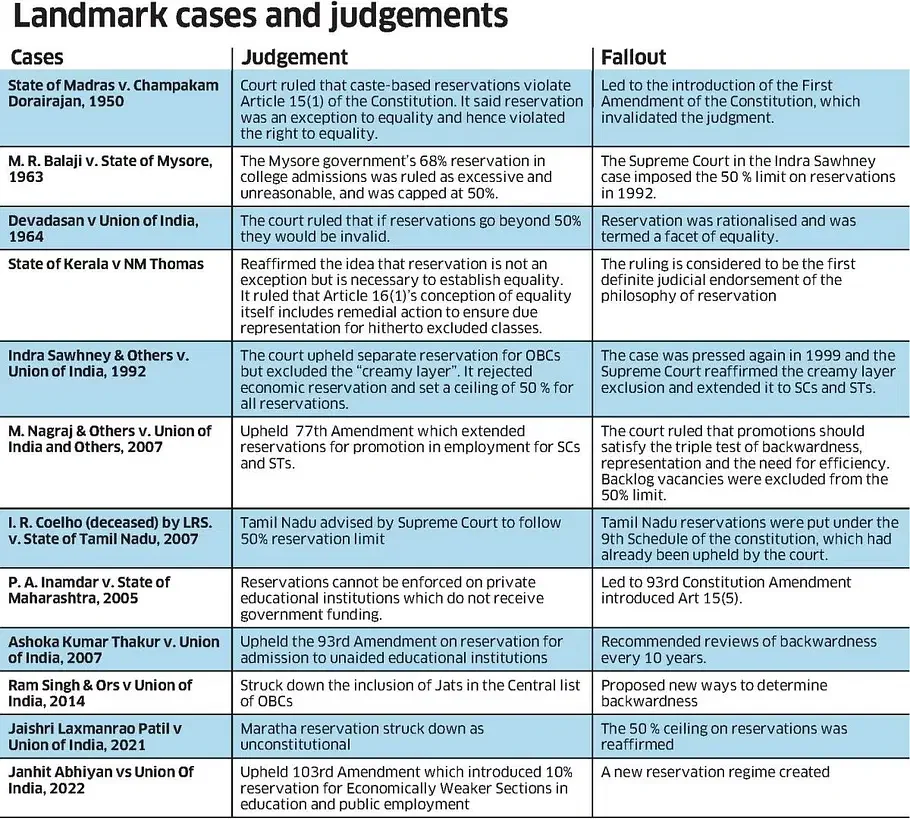Article 15 of the Indian Constitution prohibits discrimination by the State based on religion, race, caste, sex, or place of birth. It lays down specific rules to ensure that no citizen faces unfair treatment in various public and private spaces. Article 15 also provides for special provisions for certain groups to advance their social and educational status. This framework is essential for promoting equality and addressing historical disadvantages.
Right to Equality: Article 15 and Its Provisions
Article 15 – Prohibition of Discrimination on certain grounds
- Article 15 (1): The State shall not discriminate against any citizen on grounds only of religion, race, caste, sex, or place of birth.
- The two crucial words in this article are ‘discrimination’ and ‘only’.
- The term discrimination means to make an adverse distinction with regard to or to distinguish unfavorably from others.
- The word ‘only’ gives permission to discriminate on the basis of other provisions, for example, academic basis, etc.
- Article 15 (2): No citizen shall on the grounds only of religion, race, caste, sex, place of birth, or any of them, be subject to any disability, liability restriction or condition with regard to –
-
- Access to shops, public restaurant, hotels, and place of entertainment or
- The use of wells, tanks, bathing ghats, roads and places of public resorts maintained wholly or partly out of state funds or dedicated to the use of the general public.
- It is to be noted that Article 15(2) seeks to prohibit discrimination both by the State and Private individuals whereas Article 15(1) prohibits discrimination only by the State.
| Articles | Added in the Constitution |
| Article 15 (1),(2),(3) | Original Constitution |
| Article 15 (4) | 1st Constitutional Amendment Act,1951 (related to SC, ST communities.) |
| Article 15 (5) | 93rd Constitutional Amendment Act,2005 ( related to OBCs) |
| Article 15 (6) | 103rd Constitutional Amendment Act,2019 (related to people falls under EWS category ) |
Enroll now for UPSC Online Course
- Article 15 (3): Nothing in this article shall prevent the State from making any special provision for women and children.
- This article is an exception to this general rule of non-discrimination.
- It means that the State can make special provisions for women and children.
- In this regard, the NALSA v. The Union of India case recognizes transgender as a third Gender.
- The Union Government has recently proposed a 33% reservation for women in the Parliament and the State Legislatures.

- Article 15 (4): Nothing in this article or in clause (2) of article 29 shall prevent the State from making any special provision for the advancement of any socially and educationally backward classes of citizens or for the Scheduled Castes and the Scheduled Tribes.
- Article 15 (5): The State is empowered to make any special provision for the advancement of any socially and educationally backward classes of citizens or the scheduled castes or the scheduled tribes regarding their admission to educational institutions including private educational institutions, whether aided or unaided by the State, except the Minority Educational Institutions.
OBC Reservation
OBC Reservation in India: The OBC (Other Backward Classes) reservation in India refers to the affirmative action policy by the Indian government to promote the social and educational development of these historically disadvantaged groups.
- Article 15(5) and 93rd Amendment Act of 2005: The 93rd Amendment Act of 2005 introduced the aforementioned exception in the form of Article 15 (5).
- Central Educational Institutions (Reservation in Admission) Act, 2006: To operationalize this provision, the Central Educational Institutions (Reservation in Admission) Act, 2006 was enacted by the Centre.
- This legislation mandated a 27% reservation for candidates from the Other Backward Classes (OBCs) in central higher educational institutions, including prestigious institutions like the Indian Institutes of Technology (IITs) and the Indian Institutes of Management (IIMs).
Commissions Related to OBCs
The Kalelkar Commission and the Mandal Commission are two significant commissions in India that have dealt with the issue of reservation for Other Backward Classes (OBCs)
- Kalelkar Commission
- Formation: The Kalelkar Commission, officially known as the “Backward Classes Commission,” was appointed in 1953 under the chairmanship of Kaka Kalelkar to determine the criteria for assessing backwardness.
- Recommendations: The commission submitted its report in 1955, suggesting the classification of backward classes into three categories – Backward, More Backward, and Most Backward.
- It recommended a certain percentage of reservations for these categories in educational institutions and government jobs.
- Mandal Commission
- Formation: The Mandal Commission, officially known as the “Second Backward Classes Commission,” was constituted in 1978 under the chairmanship of B.P. Mandal.
- Objective: The primary goal was to identify the socially and educationally backward classes and recommend measures for their upliftment.
- Recommendations: The Mandal Commission Report assessed that 52% of the population belonged to the OBC category. The Mandal Commission submitted its report in 1980:
- A 27% reservation in public sector and government jobs should be extended to Other Backward Classes (OBCs).
- This allocation should also apply to promotions at all stages of public services.
- If the reserved quota remains unfilled, it should be carried forward for a duration of three years and dereserved after that.
- These recommendations were implemented by the government in 1990, leading to significant political and social debates.
- Impact of Mandal Commission Report
- The government’s implementation of the Mandal Commission led to widespread protests, with students resorting to self-immolation in opposition to the government’s intent to enforce it.
- Subsequently, the implementation faced a legal challenge in the case of Indra Sawhney vs Union of India.
- Supreme Court Ruling in Indira Sawhney Case
- 27% OBC Reservations: In the Indira Sawhney case, the Supreme Court deemed the 27% reservations for Other Backward Classes (OBCs) constitutionally valid but imposed specific conditions.
- Reservation Cap: The court ruled that the reservation should not exceed the 50% cap except in some extraordinary situations. This rule should be applied every year.
- Exclusion of Promotions: The court specified that the reservation policy should not be extended to promotions.
- ‘Creamy Layer’ Concept: The concept of the “creamy layer” was introduced by the court, aiming to exclude affluent individuals from the OBC community.
- Carry-Forward Rule and 50% Ceiling: the court emphasized that the carry-forward rule, which fills unoccupied vacancies in the subsequent year, should not breach the 50% ceiling.
- Establishment of a Permanent Statutory Body: A permanent statutory body should be established to examine complaints regarding the OBC list.
- National Commission for Backward Classes
- The Parliament enacted the National Commission for Backward Classes Act,1993, and constituted the National Commission for Backward Classes (NCBC)
- 102nd Constitutional Amendment Act, 2018 provided constitutional status to the NCBC and enlarged its functions.
- This amendment inserted a new Article 338-B in the Constitution.
Criteria for ‘Creamy Layer’ Classification
Individuals from the following groups are classified as part of the ‘creamy layer’ among OBCs and are therefore ineligible for quota benefits:
- Constitutional Positions: Individuals occupying constitutional positions such as the President, Vice-President, Supreme Court and High Court Judges, Chairpersons and Members of UPSC and SPSCs, the Chief Election Commissioner, the Comptroller, and Auditor General, among others.
- Government and Public Sector Services: Those serving in Group ‘A’/Class I and Group ‘B’/Class II in All India, Central, and State services, along with employees in equivalent roles in Public Sector Undertakings, Banks, Insurance Companies, Universities, and in the private sector.
- Military and Paramilitary Personnel: Army personnel ranked Colonel and above, and their equivalents in the Navy, Air Force, and Paramilitary Forces.
- Professionals: Like doctors, lawyers, engineers, artists, authors, and consultants.
- Business and Trade Involvement: Individuals involved in trade, business, and industry.
- Agricultural and Urban Property: People owning agricultural land exceeding a specified limit and those possessing vacant land or buildings in urban areas.
- Income and Wealth Criteria: Those with a gross annual income exceeding ₹8 lakh or owning wealth above the exemption limit. Notably, the “creamy layer” income threshold has been revised multiple times: from ₹1 lakh in 1993, to ₹2.5 lakh in 2004, ₹4.5 lakh in 2008, ₹6 lakh in 2013, and ₹8 lakh in 2017.

Rohini Commission for Sub Categorisation of OBCs:
|
- Article 15 (6): The State is empowered to make any special provision for the advancement of any Economically Weaker Sections (EWS) of citizens.
- The 103rd Constitutional Amendment Act of 2019: added the aforementioned Article 15(6), leading to the central government’s issuance of an order in 2019.
- This order grants a 10% reservation to Economically Weaker Sections (EWSs) in educational institution admissions.
- Individuals eligible for this reservation are those from EWSs not covered under existing reservation schemes for SCs, STs, and OBCs. Some of the specified eligibility criteria are as follows:
- Eligibility Criteria: Individuals with a family gross annual income below ₹8 lakh qualify as EWSs for reservation benefits.
- Income Criteria: This income encompasses earnings from all sources, such as salary, agriculture, business, and profession, and pertains to the financial year preceding the year of application .
- Asset Exemptions from EWS Identification: Individuals with family ownership or possession of any of the following assets are exempt from EWS identification, regardless of family income:
- 5 acres of agricultural land and above.
- Residential flat of 1000 sq.ft. and above.
- Residential plot of 100 sq.yards and above in notified municipalities.
- Residential plot of 200 sq.yards and above in areas other than notified municipalities.
- Property Holding Test: The property held by a family in different cities/locations would be clubbed together the property holding test to determine EWS status
- Definition of Family: Family for this purpose would include the person seeking reservation, his/her parents, his/her spouse, siblings below the age of 18 years and his/her minor children.
| Note : Article 15 (4), 15 (5),15 (6) are exceptions to the general rule of non discrimination under Article 15 (1). |
Relation Between Article 14 and 15
| Aspect | Article 14 | Article 15 |
| Principle |
|
|
| Objective |
|
|
| Scope |
|
|
| Function |
|
|
| Relationship |
|
|
| Impact |
|
|
|
Enroll now for UPSC Online Course
| Must Read | |
| Current Affairs | Editorial Analysis |
| Upsc Notes | Upsc Blogs |
| NCERT Notes | Free Main Answer Writing |
Conclusion
In essence, Article 15 builds on the general principle of equality enshrined in Article 14, offering specific protections against discrimination.
- It allows for affirmative action to support disadvantaged groups while maintaining a broad prohibition against unjust treatment.
- The interplay between Articles 14 and 15 ensures a balanced approach to achieving equality and justice in society.
Sign up for the PWOnlyIAS Online Course by Physics Wallah and start your journey to IAS success today!
| Related Articles | |
| National Commission for Backward Classes (NCBC) | Major Constitutional Amendments |
| Supreme Court | ESSENCE OF INDIAN CONSTITUTION: BASIC STRUCTURE DOCTRINE UNBOUND |

 GS Foundation
GS Foundation Optional Course
Optional Course Combo Courses
Combo Courses Degree Program
Degree Program









